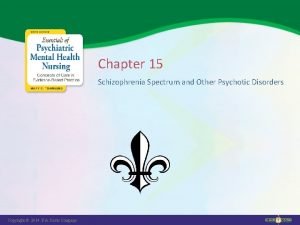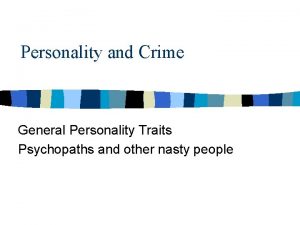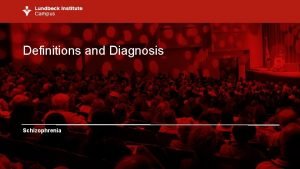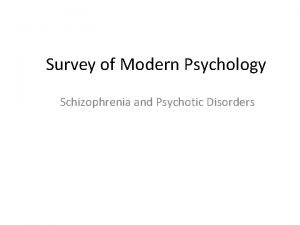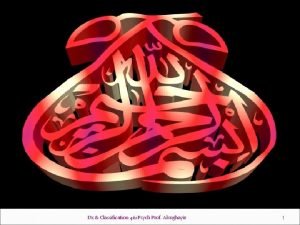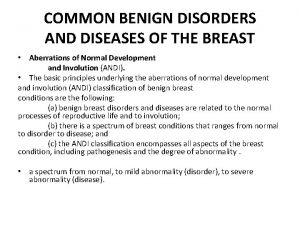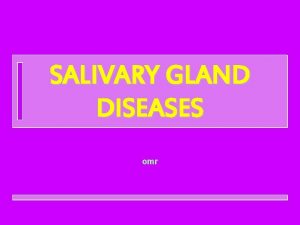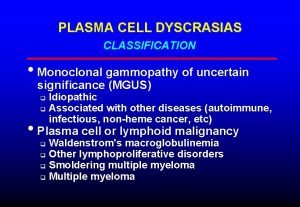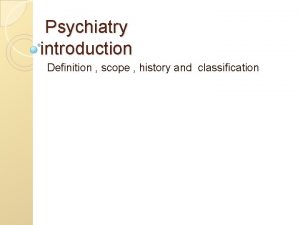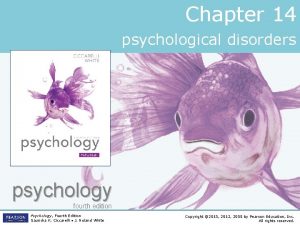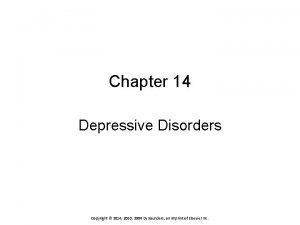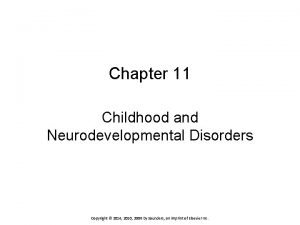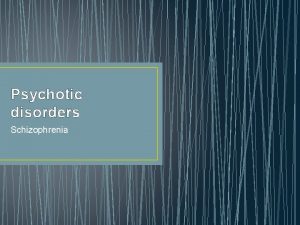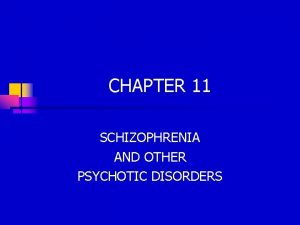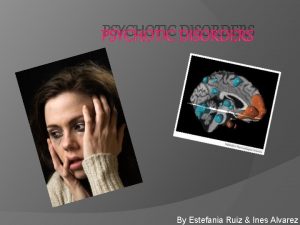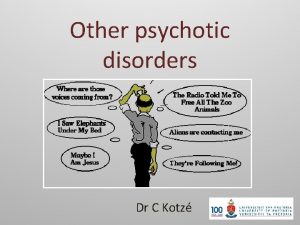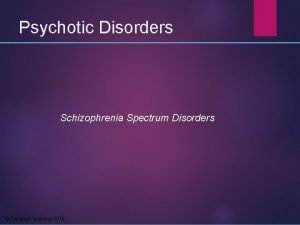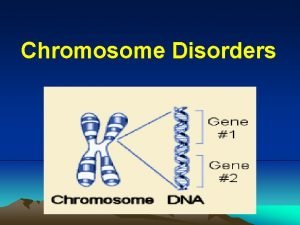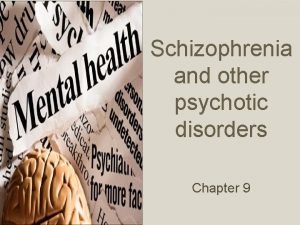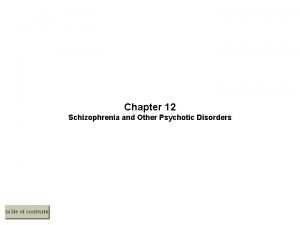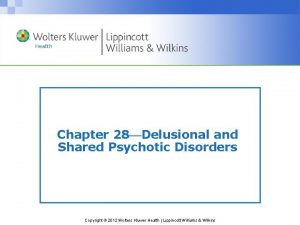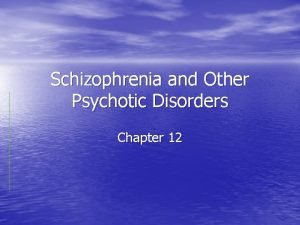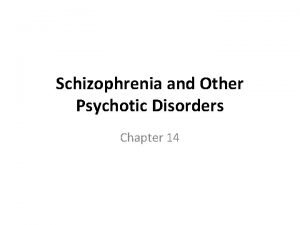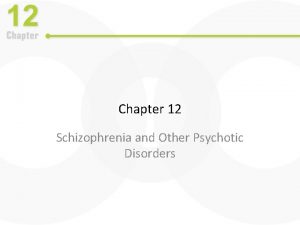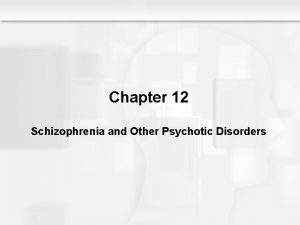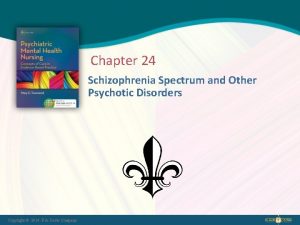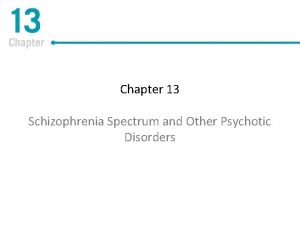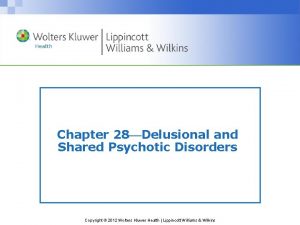Chapter 4 Psychotic disorders Classification of Psychotic disorders
























- Slides: 24

Chapter 4 Psychotic disorders Classification of Psychotic disorders: - According to ICD-10 checklist for mental disorders grouped into four categories - According to DSM-V disorders are six modules: (a) psychotic symptoms. (b) psychotic disorders. (c) mood episodes. (d) mood disorders. (e) substance use disorders. (f) anxiety, adjustment & other disorders. Psychiatric and Mental Health Nursing 1

Characteristics of Psychotic disorders: 1 - presence of some psychotic manifestations as: -Thought disturbance (e. g. delusion). - Behavioral disturbance (e. g. bizarre, aggressive) - Perceptual disturbances (e. g. hallucination) 2 - Loss of reality testing or fantasy. 3 - Insight: completely or partially lost. 4 - Affect: flat, blunt or inappropriate. 5 - Speech: incoherent. Psychiatric and Mental Health Nursing 2

Characteristics of Psychotic disorders. . Cont. Psychotic disorders linked to: Violence, include failure to take medication, drug or alcohol abuse, delusional thoughts &command hallucinations, or a history of violence. 40% of psychotic disorders do not receive psychiatric treatment on any given day, resulting in homelessness, isolation, or violence. Client admitted to hospital, or prisons, or forced to live in the streets or homeless shelters. - Psychiatric and Mental Health Nursing 3

Schizophrenia Psychiatric and Mental Health Nursing 4

schizophrenia The most common of the psychotic disorders Onset: rarely in childhood. * Peak of onset: - Men 18 - 25 years. - Women 25 – 35 Oldest age of onset between 66 -77 years. Prevalence: equal for males and females about 1% of the total population. - Psychiatric and Mental Health Nursing 5

Schizophrenia. . Cont. Etiology: According to many theories No single cause has been identified for all cases of schizophrenia. Multiple theories: (1) Genetic Predisposition Theory - 60% of people with schizophrenia have no close relatives with the illness. - 10% Risk of inheriting schizophrenia with those who have one immediate family member diseased. - 40% occurs if the disease affects both parents or an identical twin. Psychiatric and Mental Health Nursing 6

Schizophrenia. . Cont. (2)Biochemical and Neuro-structural theory: - Dopamine hypothesis: increase amount of dopamine allows nerve impulses to be involved in arousal. - Normal cell communication is disrupted, resulting in development of hallucinations and delusions. - Cause of high levels of dopamine unknown. but neuroleptic (anti psychotic) medication blocks excessive release. - Recent suggests schizophrenia involves problems with brain chemistry and brain structure. Psychiatric and Mental Health Nursing 7

Schizophrenia. . Cont. (3) Environmental or Cultural Theory low socioeconomic persons or singleparent homes have low social skills, become at risk for developing schizophrenia. (4) Psychological Theories: 1 - Psychoanalytic theory: states that distortions in the child mother relationship make the child unable to progress beyond dependence, This affects on ego organization and the interpretation of Psychiatric and Mental Health Nursing 8

Schizophrenia. . Cont. 2 - Learning theory: poor parental models in early childhood affect future interpersonal relationship, and irrational ways in handling situations. 3 - Stressors theory: some Stressors contribute to onset of schizophrenia e. g. - Poor mother child relationships, deeply disturbed family , impaired sexual identity and body image, rigid concept of reality. Cont. . Psychiatric and Mental Health Nursing 9

Schizophrenia. . Cont. Repeated exposure to double-bind situations, there is no correct choice Example: a parent tells a child who is wearing new white tennis shoes you may go out to play when it stops raining At the same time, parent's body language and facial expression give message that the parent prefers the child staying indoors. The child does not know which message to follow, producing confusion, anxiety and fear in child's mind. Psychiatric and Mental Health Nursing 10

Schizophrenia. . Cont. Clinical Description: Symptoms: -Tension, the inability to concentrate, insomnia, withdrawal, or cognitive deficits may precede the first psychotic episode. Clinical symptoms three broad categories: 1 - Positive (type I) symptoms: such as hallucinations, delusions, or suspiciousness, & bizarre behavior and Psychiatric and Mental Health Nursing 11

Schizophrenia. . Cont. 2 - Negative(type II) symptoms: loss of normal functions, e. g. Inability to enjoy activities; flat or inappropriate affect, Alogia (inability to speak), Avolition (inability to make decision) , Poor eye contact, Social withdrawal, poor hygiene, apathy. 3 - Disorganized symptoms: recently added. E. g. confused thinking, incoherent or disorganized speech and behavior such as the repetition of rhythmic gestures. Psychiatric and Mental Health Nursing 12

Schizophrenia. . Cont. Course: - At least 6 months, includes three phases of symptoms: (1) Prodromal phase: lasts: - Few days if the onset is sudden. - Few months if the onset gradual. - Characterized by strange behavior, perception, flat affect, &bizarre ideas. - Impairment in : - social activities, personal hygiene, &physical or recreational activities previously was enjoyable. Psychiatric and Mental Health Nursing 13

Schizophrenia. . Cont. (2) Active phase: at least one month, symptoms become more sever to meet the diagnostic criteria of schizophrenia. (3) Residual phase: At end of the active phase positive symptoms is absent or attenuated, and negative symptoms become more prevalent. This phase may continue to complete remission or exacerbation. Psychiatric and Mental Health Nursing 14

Schizophrenia. . Cont. Diagnostic Criteria DSM-V: A. Active-phase symptoms: Two or more of the following, present for a significant portion of time during a 1 -month period. At least one of these must (1 ), (2), or (3): 1. Delusions. 2. Hallucinations. 3. Disorganized speech (e. g. derailment or incoherence) 4. catatonic behavior. 5. Negative symptoms (i. e. , diminished emotional expression or avolition). Psychiatric and Mental Health Nursing 15

Schizophrenia diagnostic criteria. . Cont. B. Disturbance in one or more major function e. g. ( work, interpersonal relations, self-care) C. Signs of the disturbance persist for at least 6 months (may include periods of prodromal or residual symptoms) D. Schizoaffective disorder and depressive or bipolar disorder ruled out because either: - No major depressive or manic episodes occurred concurrently with active-phase. Psychiatric and Mental Health Nursing 16

Schizophrenia diagnostic criteria. . Cont. E. The disturbance not related to physiological effects of a substance or other medical condition F. If there is a history of autism or communication disorder in childhood additional diagnosis of schizophrenia is made only if prominent delusions or hallucinations + other active phase symptoms of schizophrenia. (For at least one month). Psychiatric and Mental Health Nursing 17

Schizophrenia. . Cont. Suicidal Risk: 5 – 6% schizophrenics die by suicide 20% attempt suicide in one or more occasion. - Many have suicidal ideation. - High for younger males with substance use, unemployed, & in the period after psychotic episode or hospital discharge - Suicidal behavior may be response to command hallucinations. Psychiatric and Mental Health Nursing 18

Subtypes of schizophrenia: (Paranoid, catatonic, disorganized or hebephrenic , undifferentiated and residual) have been dumped in the DSM-V because of their “limited diagnostic stability, low reliability, and poor validity, ” Cataplexy: sudden transient episode of muscle weakness accompanied by full awareness, triggered by emotions such as laughing, crying Psychiatric and Mental Health Nursing 19

Catatonia was not classified independent class, it can occur with several disorders as: a) Catatonia associated with another mental disorders: ( e. g. psychotic, bipolar disorder, & depressive disorder. . ) b) Catatonia associated with another medical condition (e. g. cerebral folate deficiency (low CSF), autoimmune and neoplastic disorders). Psychiatric and Mental Health Nursing 20

Clinical picture of catatonia: Three or more of the following symptoms: 1. Stupor ( no psychomotor activity; not relating to environment). 2. Catalepsy (muscular rigidity and fixity of posture regardless of external stimuli). 3. Waxy flexibility (resistance to positioning by examiner) 4. Mutism (no, or very little, verbal response). 5. Negativism (not response to instructions) 6. Posturing (active maintenance of a Psychiatric and Mental Health Nursing 21

Clinical picture of catatonia: … cont. 7. Mannerism (odd style in behavior e. g. caricature). 8. Stereotypy (persistent purposeless mechanical repetition of speech or movement) 9. Agitation not related to external stimuli. 10. Grimacing: (ugly or contorted facial expression) 11. Echolalia (repetition another’s speech). 12. Echopraxia (repetition of another’s movements) Psychiatric and Mental Health Nursing 22

Subtypes of catatonia: 1 - Catatonic stupor: apathetic, little or no motor activity & eye contact. - May remain in one position for a long period of time, then go directly to another position immediately. 2 - Catatonic excitement: Constant purposeless agitation and excitation. May also present delusions or hallucinations Considered one of the most dangerous mental states in psychiatry Psychiatric and Mental Health Nursing 23

Standing woman (catalepsy) Sleeping ones (cataplexy) Psychiatric and Mental Health Nursing 24
 Types of psychotic disorders
Types of psychotic disorders Qualities of a psychopath
Qualities of a psychopath Difference in dsm 4 and 5
Difference in dsm 4 and 5 Types of delusion
Types of delusion Neurosis vs psychosis
Neurosis vs psychosis Andi breast disease
Andi breast disease Salivary gland disease classification
Salivary gland disease classification Waldenstrom macroglobulinemia mnemonic
Waldenstrom macroglobulinemia mnemonic Classification of mental illness
Classification of mental illness Medical model psychology
Medical model psychology Chapter 11 genetic disorders concept mapping
Chapter 11 genetic disorders concept mapping Chapter 8 skin disorders and diseases
Chapter 8 skin disorders and diseases Chapter 6 musculoskeletal system
Chapter 6 musculoskeletal system Chapter 46 digestive and endocrine disorders
Chapter 46 digestive and endocrine disorders Types of somatic disorder
Types of somatic disorder Chapter 29 endocrine and metabolic disorders
Chapter 29 endocrine and metabolic disorders Chapter 21 mental health diseases and disorders
Chapter 21 mental health diseases and disorders Chapter 18 psychological disorders
Chapter 18 psychological disorders Chapter 18 eating and feeding disorders
Chapter 18 eating and feeding disorders Chapter 17 reproductive system diseases and disorders
Chapter 17 reproductive system diseases and disorders Chapter 15 nervous system diseases and disorders
Chapter 15 nervous system diseases and disorders Chapter 15 anxiety and obsessive-compulsive disorders
Chapter 15 anxiety and obsessive-compulsive disorders Chapter 14 psychological disorders
Chapter 14 psychological disorders Chapter 14 depressive disorders
Chapter 14 depressive disorders Chapter 11 childhood and neurodevelopmental disorders
Chapter 11 childhood and neurodevelopmental disorders
